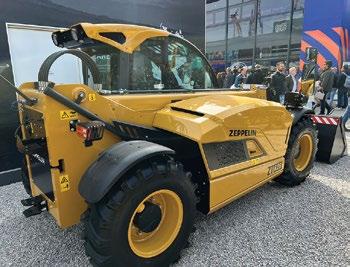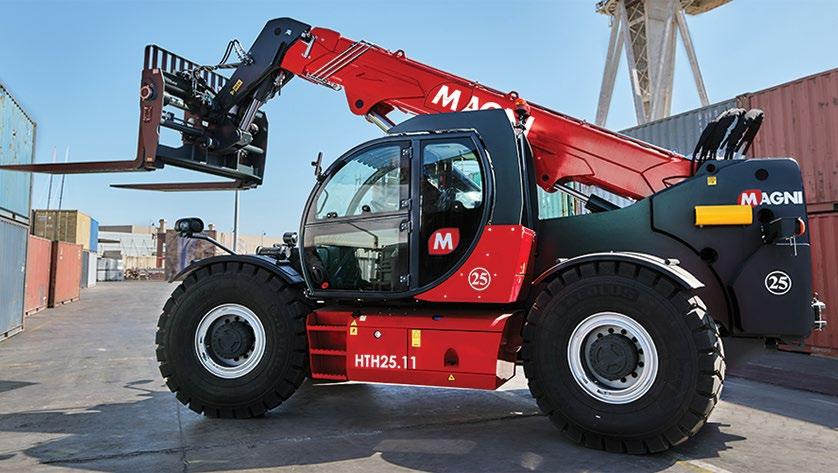
27 minute read
Jack of all trades, master of…
Jack of all trades, master of…
For whatever the reason, it would appear that sometime over the past two or three years numerous equipment manufacturers all had the same idea…that the next ‘big thing’ was going to be telehandlers, with Bauma 2025 serving as the target for their main product launch.

Everywhere you looked at this year’s big show in Munich there was a new model or even a new manufacturer with machines on display, and while most of the newbies came from China there were also machines from Turkey and India. Why all these manufacturers think it is such a good idea to enter an already very competitive, busy, well established market with local and global players - such as Manitou, JCB, Merlo, JLG and more recently Magni and others - is something of a mystery. But the market is now becoming very crowded, and it will be interesting to see how the new players cope with being small fish in a big pond. It has overtones of an old fashioned gold rush and its hard to see many, if any, making their fortune.
There are two major basic design types of fixed frame telehandlers. The majority of those produced are of the European style ‘low boom’ models manufactured by the global players and sold throughout the world. These are available in compact, medium and larger fixed frame models, 360 degree or roto machines and Heavy Duty high capacity beasts. Although the low boom style of machine is gaining in popularity in North America, particularly at the compact end of the market, the vast majority of telehandlers sold in the region are ‘high boom’ versions produced by the likes of Xtreme, JLG/Skytrack, Skyjack and Pettibone. Because of the size of the market, manufacturers such as JCB, Manitou and more recently Chinese companies LGMG, Sany and Sunward are also producing ‘high boom’ versions specifically for the American market. Globally, the vast majority - about 80 percent - of telehandlers are aimed at the construction sector but there are also agricultural versions.

The main reason behind the rise in the number of manufacturers entering the telehandler market must be down to a notion that sales are about to take off, not only in established markets, but more importantly in markets likely to adopt them in the near future. There was significant growth in the use of telehandlers in industrial, construction and agricultural markets around 20 years ago, thanks to the rapid rise of materials transported to site on pallets, combined with the realisation that the growing range of different attachments which can be quickly swapped with the standard forks allow the telehandler to carry out a wide range of other duties. Over the years the telehandler’s ‘Swiss Army Knife’ and ‘jack of all trades’ ability has helped cement its place as an essential material handling solution across many parts of the world. Today there are models to suit all applications, from tiny compact, easy to transport versions for working in tight spaces such as farm buildings, basements and tunnels etc with industrial models to work on the factory floor and in the yard, through to the largest 360 degree units which can replace a 40 tonne mobile crane in many applications, and the Heavy Duty versions that can lift as much as 50 tonnes.



Strong growth
In or around 2005, global sales began to increase substantially, partly due to strong growth in the USA, resulting in annual worldwide sales in the region of 40,000 - 45,000 units or more, this remained relatively steady for the next 15 years. More recently sales have been increasing steadily to a point where there are around 70,000 units a year, with many predicting this to increase adding in the region of 20,000 units to annual sales over the next five years - and this without a domestic Chinese market. Back in 2005 there were about 20 manufacturers producing telehandlers. Today that figure has almost doubled with 38 manufacturers listed in last month’s C&A Source Guide. Most of the newcomers are companies based in China, all of them tempted into the market in the belief in the predicted growth expectations over the next few years being exceeded. It is quite possible that a check of the Chinese government product trend research studies and forecasts will shed some light on this phenomena.

Never plain sailing
Given their relatively ‘simple’ and consistent design it is hard to understand why major construction equipment manufacturers have found the telehandler market to be so much of a challenge and no longer produce telehandlers, or even contest the market, leaving it to the more specialist companies with decades of experience.


Looking at the world’s leading non-Chinese heavy equipment manufacturers - Caterpillar, Case, New Holland, Deere, Volvo and Komatsu etc - all have at one time or other have had a go at the telehandler market and failed. Now it’s the turn of the three largest Chinese construction equipment manufacturers - XCMG, Sany and Zoomlion - to have a go at cracking the telehandler market, along with a good few smaller manufacturers. Have they discovered something the others missed? At the moment there is no discernible domestic market in China, however might this be about to change in spite of a weak construction market there. There is also growing telehandler interest in markets such as Turkey and parts of Asia which may keep local manufacturers happy, but not the big full line players.

The European telehandler market has for many years been dominated by JCB and Manitou with others some distance behind. In the US, back in the 1990s JLG’s acquisitions of Omniquip/ Lull/Skytrack etc made it the dominant player in North America where customers liked high boom models without all the fancy cabs and trappings expected in Europe. In a way it created a sort of non-tariff barrier, forcing JCB and Manitou to design market specific machines which they build locally. The question often asked is whether this is changing or not? Well, when it comes to the compact - six metre/2,500kg - models which are beginning to sell in decent numbers, the vast majority are European designed and built as are the sub compact units. In fact in 2024 JLG acquired Ausa, one of the leading players in the four metre market, which it is promoting in the USA.
Price, of course, is a factor. If the new players are able to undercut the market price - which is doubtful as they all use similar componentsthey will be accused of dumping. If they are only slightly less expensive let alone more, customers will not even consider changing brand. In the telehandler rental market product commonality and well established resale values are critical as is the ability to maintain 90 percent utilisation levels without issues.
History has shown us that no matter how big the manufacturer, building a telehandler at a cost that allows them to be price competitive is a struggle, and as a late comer price matching simply will not cut it. The top European producers have been perfecting and refining all aspects of their design, manufacturing and marketing for many decades and are market leaders for good reason.

Successful new entrant
Having said all that, one company, Magni - a startup - has managed to pull it off spectacularly, demonstrating that it is possible to enter the sector and succeed. However it had a few major ingredients in its favour. The ‘new’ company was formed in 2013 by an industry veteran and pioneer Ricardo Magni, he had more than 30 years’ experience with fixed, rotating and heavyduty telehandlers having previously been chief executive of Manitou’s Italian subsidiary MCI which he and his father Pietro Magni founded originally as Fargh initially selling a minority stake to Manitou and then after a few years the remaining balance. Back in 1980 they had designed and built their first telescopic handler having experimented with designs that imitated the American manufacturer Lull’s sliding chassis carriage using twin booms. When this failed to be a raging success, he followed Merlo into the 360 degree market. As the 360 market took off Manitou started looking for a quick way into the market to satisfy its dealers asking for something to fend off Merlo. Buying a stake in the Magni family business seemed a good way to go, also providing it with an Italian factory in which to build them.

After having sold the rest of the shares to Manitou and seeing out any contractual requirements, he announced that he was returning to the telehandler market. Most seasoned telehandler people thought he was crazy, but Ricardo Magni had a cunning plan. He set up a new plant opposite the Manitou facility and designed a machine to compete in the 360 degree market, avoiding the highly competitive six to 17 metre fixed frame mass market.
His new models had a far higher specification than anything on the market, with fully glazed super deluxe pressurised cabs, numerous attention to detail concepts along with advanced user friendly electronics, while using the very best quality componentry, at one point installing JCB engines in order to tempt JCB dealers looking for a 360 degree product. Within two years the company had produced the top two telehandlers in terms of lift height and lifting capacity. He went on to enter the regular fixed frame market with a chart topping 20 metre model, followed by more commonplace units and last year a slightly higher capacity - 3,000kg - compact machine, already selling more than 1,000 units.
At Bauma early this year - 12 years on - the company launched several new models taking its RTH 360 degree range up to 20 different models, with lift heights from 18 to 51 metres and capacities from five to 13 tonnes, while also massively expanding its production facility and buying more land for further development. Its TH fixed frame models now cover all sectors from six to 24 metres and capacities from three to seven tonnes, while its high capacity heavy duty HTH models run from 10 to 14 metres lift height and capacities from 10 to 50 tonnes.

Attachments
The one thing that separates the telehandler from most other items of lifting equipment is that it can carry out numerous different tasks by changing the front end attachment. Most common are the forks and buckets of course, but the variety of different attachments is now quite mind boggling, ranging from all manner of work platforms, to tree cutting equipment for arborists and winches to lift loads and compete with mobile cranes which makes the telehandler a jack of all trades or is it master of none? These attachments are certainly more often specified with 360 degree models with the larger versions a cost effective alternative to a 40 tonne Rough Terrain or All Terrain crane.
Ricardo Magni maintains that sales for its larger 360 machines are growing - particularly in the USA - because contractors are realising that by purchasing one large telehandler with a platform attachment and winch costs somewhere in the region of €400,000 - a substantial saving compared to buying - or renting - a crane and a 50 metre boom lift.

At Bauma 2025 Magni launched its TP 4,5.10 platform for use with its RTH models allowing working heights up to 53 metres with the RTH 6.51. The platform has a capacity of 450kg over its entire length and has 360 degree platform rotation with the ability to luff up to 20 degrees when the boom is extended.
Most telehandler manufacturers offer a wide variety of attachments as well as many independent attachment companies. Including rotating and tilting compatible fork carriages such as Romaster the inventor of the fully rotating forks carriage (see article on page 44).
Magni has launched its badged version of the Romaster product - a five tonne rotating and tilting FEM/ISO standard compatible fork carriage. The attachment has been designed specifically for handling bulky materials in tight spaces and can rotate its forks a full 360 degrees at a height of up to three metres with automatic restriction to 90 degrees either side of centre when the boom is elevated higher, in order to prevent the load fouling the boom, although this varies to suit the job. In addition to the rotation, the carriage can tilt by up to 70 degrees to keep the load stable and make it easier to load or unload materials. The carriage is compatible with all Magni TH fixed frame and RTH 360 degree models, with a maximum capacity over the front of 2,300kg on the more compact TH models to a maximum of 5,000kg on the RTH models. The capacity with the forks rotated 90 degrees is 2,500kg on all compatible models.

Eco machines
Like other equipment sectors, telehandler manufacturers have been working hard to decarbonise their machines. Faresin was the first company to launch and ship an all electric telehandler - the six metre/2,600kg 626 - in April 2019 having unveiled it about six months earlier. It was not until 2022 that the company unveiled the Full Electric 17 metre/4,500kg 17.45 with the first unit being sold to Flannery Plant Hire in the UK. However, Manitou says that is aiming to be the key player when it comes to decarbonisation, working for many years on the development of electric and hydrogen powered machines. After presenting an initial prototype of a fixed frame 18 metre/4,000kg model in December 2022, Manitou launched a second zero emission telehandler prototype concept at Bauma powered by green hydrogen via a fuel cell.
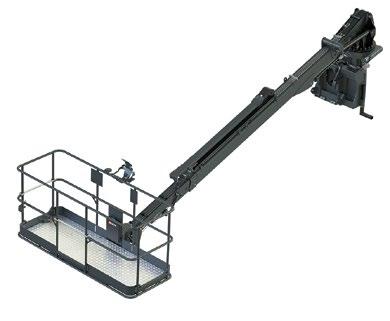
Manitou unveiled two other new electric telehandlers at Bauma - the MT 1440e and MT 1840e - which the company claims offer the same performance as the diesel versions but with up to 75 percent savings on energy costs.
Battery warranty is five years or 3,000 hours to 70 percent battery SOH (State Of Health). Also launched was the 360 degree, 40 metre/7,000kg MRT 4070 with 21 metres of forward reach. New attachments include the high-strength steel pruning grapple for the MRT 2660e, which can be used to cut and fell trees and branches up to 750mm in diameter and the 360 degree rotating forks and a new faster six tonne winch.
Retrofit machines
Since early 2023 Manitou has been working with French international rental group Kiloutou and Bouygues Construction Matériel to convert older diesel telehandlers to refurbished electric models. The first real life trials of their ‘retrofit telehandler’ began earlier this year. The first machine is currently working on Europe’s largest hospital construction site in Nantes allowing the three partners to evaluate the viability of what they believe is a sustainable and circular solution.
Feedback on the machine’s performance and charging has apparently been good as well as cab comfort, battery life and the fact that one hour opportunity charging can input 25 percent to the battery pack allowing it to operate for more than three hours without interruption.

Manitou chief executive Michel Denis said: “This testing phase, focused on user needs and expectations, is very important to validate this electrification kit. Initial feedback from the construction site is very encouraging, with performance largely comparable to a combustion engine, combined with a significant reduction in noise and zero carbon emissions. We still have a few months of testing, but the project is truly promising. We share the same conviction as Kiloutou, and we confidently envision the potential of retrofitting, in line with our commitment to making the circular economy a cornerstone of our CSR strategy.”

Smaller electric machines
Following Faresin, there are now several manufacturers with all-electric, compact telehandlers. The latest comes from Hangcha unveiled at the Hire25 show in Melbourne, while Sany is looking at electric models to help it develop a broad range of fixed telehandlers using European experience and know-how. Its latest addition launched at Bauma is the compact six metre/2.5 tonne all electric STH625e. With four socket adapter plugs the 34kWh battery can be charged with any power socket from 230V/370V AC, giving a claimed eight hours working. Sany’s E-Power energy recovery system claims it can save up to 15 percent power from regenerative braking and harnessing boom lowering forces.
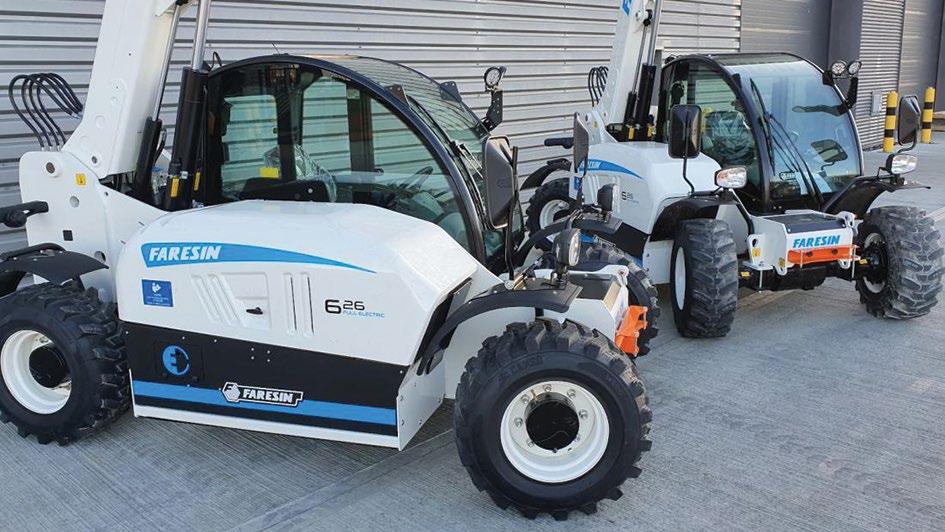

Weighing five tonnes, the unit has an overall width of 1.85 metres, is 1.92 metres high and four metres long. The 96Ah battery gives a 20kph travel speed via a two forward/reverse speed transmission. Three steering modes include 4WD, 2WD, crab and features include Sany’s fast fit carriage with 1,200mm forks although a Manitou carriage with fork frame is optional as is a fast three phase charge. The unit can take 2,000kg to its maximum lift height and 800kg at its maximum 3.35 metre forward reach. Standard features include full LED road lights and seven working lights on the cab and boom, a 10 inch touchscreen display, well appointed cab and onboard charger. The machine has a three year/3,000 hour warranty and five year/10,000 hour warranty for the battery.


This all-electric six metre compact sector has several more players including LGMG, JCB and Dieci. LGMG’s battery electric six metre/2,500kg H625E was released at Bauma China last year. It is the company’s first electric telehandler and can take two tonnes to its maximum lift height of 5.94 metres and handle 800kg at its maximum 3.41 metres of forward reach. The 2,500kg maximum capacity is available at a five metre lift height, or 1.3 metres forward reach. The unit has an overall length of 3.99 metres, an overall width of 1.86 metres and stowed height of just under two metres. Overall weight is just under five tonnes. Four wheel drive and steer are standard with a maximum road speed of 16kph. Power comes from an interchangeable 80V/340Ah Lithium-Ion battery pack, feeding an electric motor for the drive and one for the hydraulic pump. The range of attachments includes work platforms, buckets, jib hooks and rotating fork carriages with standard couplings.

The changing world of global tariffs and rising transport costs has meant several manufacturers setting up manufacturing facilities nearer to main markets. LGMG is one of these and earlier this year celebrated its first telehandler produced at its Mexican plant in Marin, on the North side of Monterey, Nuevo León. The machine - a 17.1 metre H1056 American style telehandler - features an open cab, and typical American market basic specification. Two more models are planned over the next year or so, including the 5,400kg/17 metre H1256, and the compact six metre/2,500kg H5519.
At the end of last year Dieci unveiled the Mini Agri-e Smart and Apollo-e Smart, a year after launching its first all-electric models - the Mini Agri-e and Apollo-e 26.6. The new models are targeted at use in buildings, city centres, greenhouses and protected areas and have a maximum capacity of two tonnes, a lifting height of 4.35 metres, a maximum speed of 20kmh and a 3.1 tonne towing capacity. Overall weight is 4.4 tonnes.
The machines are equipped with a 22kWh lithium battery which can be charged through three connections with the engine hood closed to prevent potential theft/vandalism. They also feature high and low energy waste, an adaptive load sensing system, low noise pumps and a seven inch display offering a 3D like view of vehicle functions.
New names and models
Many little known manufacturers are also launching new products and dipping their toes in the water. Vanse from China was a first time exhibitor at Bauma and showed a 13.5 metre/4,000kg WSC1440 telehandler. It also has a seven metre/4,000kg WSC740. Capacity at maximum height is 3,000kg and 3,300kg respectively with overall weights of 10.6 and 7.8 tonnes. Vanse - formally Shandong Vanse group - was founded in 2013 and produces concrete equipment along with wheeled and tracked dumpers. It comprises many divisions including Vanse Machinery, Wanhui New Energy, Wanli Precontrol Machinery Manufacturing, Vanse Road and Bridge and Shanghai Vanse Machinery. It claims to export to 30 countries including the USA, UK, Russia, Germany, Saudi Arabia and Australia.

Turkish earthmoving manufacturer Hidromek launched its first telehandler prototype - the 4,000kg/18 metre HMK 40-18 TH - at Bauma. The new machine has a four section boom with top mounted telescope cylinder and chain system. It has modern angular styling, a high pressure piston type hydraulic pump, power shift transition and reverse fan cooling. Maximum lift height is 17.65 metres, with 13.1 metres of forward reach. Overall width is 2.4 metres, overall stowed length 6.4 metres and overall height 2.55 metres, while total weight is 12,500kg. Another first was India’s ACE Equipment with its AT350 telehandler, and although it was displayed at Bauma, information on the brand new model is scarce.

German Caterpillar distributor Zeppelin launched its Faresin badged models at Bauma, under a new partnership programme for fixed frame telehandlers in Germany and Austria. In total there are 10 models from six metres/2,600kg to 17 metres/4,500kg in both diesel and all electric versions.
A relative newcomer to the European telehandler market is Noblelift, best known for its pallet trucks and forklifts but it unveiled a new compact telehandler - the FTN25N - at Bauma, while also promoting its full range of Malaysian built scissor lifts.
After many years of seeing a Sunward telehandler at a trade show only for it to disappear at the next, it would appear the company is now making a concerted effort to ‘crack’ the market. Last year Laurent Pons - previously with Manitou - was given the go ahead to develop Sunward’s aerial lift division which includes telehandlers along with boom and scissor lifts as well as five and 10 tonne telescopic crawler cranes. Its latest telehandler is the European-style 3,500kg/7.4 metre SWTH 3507. The company says that it also has high boom machines for the North American market.

German company Thaler has launched a compact 4.8 metre/1,800kg 48T18 weighing 3,350kg with an overall width of 1.8 metres and height of just under two metres.
Zoomlion now has a five fixed model range including the ZTH2506, ZTH3507, ZTH3513 and the recently launched 14 metre/4,000kg ZTH4014 and the 18 metre/4,000kg ZTH4018. It also has two 360 degree machines - the 4.5 tonne/18 metre ZTH4518R and the 4.5 tonne/25 metre ZTH4525R.

Faresin’s new Middle series of FS Next Generation telehandlers have lift heights of seven to 10 metres and capacities of 3,500 and 4,000kg. Features include a new tapered engine cover reducing operator blind spots as well as a redesigned interior and LED lighting. All models have the S420 steel booms with double C-profile. Faresin has also replaced its six metre/2,600kg FR6.26 of which more than 2,000 units were sold. Changes include visibility improvements and an electronically controlled, stepless transmission.
As well as launching a new range of four Chinese built RT forklifts, Magni launched two new midrange telehandlers - the TH 3,5.7 and the TH 3,5.9 - with 3,500kg capacity and lift heights of seven and nine metres respectively. Standard on both is a full LMI system which monitors machine movements showing relevant load data in real time, Deutz diesels, hydrostatic transmission with Dropbox for gradeability up to 89 percent and a maximum speed of 32kph. Both are two metres high and just over two metres wide. Also new is the RTH 6.31 TC, its first model with a tilting cab which will be followed by the RTH 6.22 TC and the RTH 6.26 TC. In the heavy duty category, the new HTH 25.11 has a 1,000kg capacity increase to 25,000kg compared to its predecessor the HTH 24.11.

Merlo has introduced 10 all new Roto 360 degree models, with 1,000kg more capacity and improved lift heights as well as new features and design, with more compact dimensions and lower ground bearing pressures. The new models are in three ranges - the Roto 400 with 400 degrees of slew, the 600 - ‘you get it’ - with 600 degrees, and the Roto with 360 degrees continuous slew. The 400 models include the 16 metre Roto 50.16 and 18 metre 50.18 both with 5,000kg capacity.
The 600 models include the 21 metre Roto 50.21 and 26 metre 50.26, while those with continuous slew include the Roto 60.22, 60.27, 60.30 and 60.35 all with 6,000kg capacity, and finally the 7,500kg/25 metre/75.25 and 28 metre 75.28.
Machines are available with S or R spec. The R ‘rental’ models offer the same power and performance as S Plus models but with simplified management and operation, ideal when used by multiple operators.

Improvements to the electronic functions including a smoother and more linear boom operation and a “Set Point” function allowing the automatic return of the boom to a memorised position at maximum speed increasing efficiency in repetitive work cycles.

The introduction of load chart simulation function allows the operator to know before commencing the operation of its feasibility simply by simulating the variation of the known parameters - attachment used, load to be lifted, stabiliser position etc.
A new patented radio remote controller provides more machine information, while the background on the LCD display screen changes colour in abnormal or dangerous situations to alert the operator and only allows movements that return the machine to a stable and safe situation.
And now for something different….
Start-up company QuiMo (Quick Motion) based in Sauldorf-Boll, southern Germany, has launched a highly unusual and innovative electric powered two wheel telescopic loader with a 1,600kg maximum capacity at a height of 2.8 metres on the forks, or 1.9 metres with the bucket attachment and a forward reach of 500mm at full capacity.
The machine is 2.2 metres long with forks attached, has an overall width of 1.2 metres and is two metres high. Overall weight is 1,800kg so it almost lifts its own weight. The drive system features dynamic balancing control with an auxiliary support wheel. The company says the electric drive system achieves 40 percent lower energy consumption compared to standard electric loaders thanks to its lighter overall weight. The compact design enables transport via a car sized trailer. Safety features include centre of gravity monitoring, automated counterweight positioning and remote control operation with integrated load sensing and assistance functions.

AI vision
Now that battery power - even for telehandlers - is almost ‘old hat’, the next ‘new’ technology appears to be Artificial Intelligence. Several manufacturers have produced prototype models showing off what is possible including JCB which launched its Intellisense pedestrian recognition system last year, designed to detect pedestrians within a pre-set proximity of the machine. The system sets off audible and visual warnings inside the cab for the operator and externally to warn anyone in the immediate vicinity. The system uses four cameras - three giving 270 degrees AI camera coverage around the sides and rear of the machine and a standard forward facing camera. It will initially be available on the 4,000kg/14 metre 540-140 and 3,500kg/12.5 metre 535-125 telehandlers. Full integration with JCB’s LiveLink telematics system allows data to be accessed from a single source with machine and cloud data storage as standard. It also provides an alert button that allows the operator to record a 10 second data segment that is automatically stored.
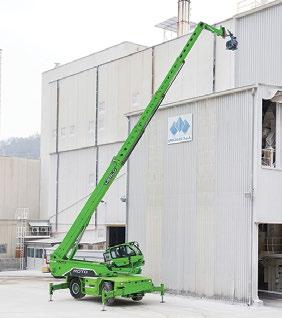
Dieci more recently unveiled its Hi-Vision system, featuring Artificial Intelligence visual assistance to its Pegasus Elite 360 degree models. The system uses six high resolution cameras providing visibility up to 30 metres, three lidar sensors for 3D environmental mapping, a central processing unit and a cab mounted display screen. It can display real time warnings for person detection around the machine, obstacle identification in outrigger zones, ground condition monitoring and attachment change assistance. The system will be installed on three models - the 10 tonne/29 metre Pegasus 100.29, the 35 metre/7,000kg Pegasus 70.35 and the 40 metre/6,000kg Pegasus 60.40.

Telehandler badging
There have been many instances of OEM’s supplying other manufacturers with badged telehandlers over the years including JLG for Caterpillar and Magni for Bobcat 360 degree machines. Cat dealer Zeppelin now works with Faresin after Cat gave up on its European telehandlers, and now German forklift and logistics equipment manufacturer Linde is branding Sennebogen’s new 8.5 metre/6,000kg 360 G and 7.7 metre/4,000kg 340 G models, to create Linde heavy duty telehandlers in the form of the YH40 and YH60.

Sennebogen has been producing its heavy duty telehandlers since 2018 and now builds them in a specific facility in Wackersdorf, north of Munich. According to Sennebogen, the deal significantly expands its market coverage with machines that include elevating cabs and a very high basic specification. The new 360G replaces the current 5,500kg/8.45 metre 355 E, and has a 4.37 metre forward reach at which point it can handle 2.3 tonnes, while it can take 5.5 tonnes to its full lift height. The unit has an overall width of 2.55 metres, and overall stowed length of 5.7 metres without forks and is 2.65 metres high. Total weight is 12,500kg. The main attraction for these machines is heavy duty cycle work, replacing wheel loaders in a variety of applications, where variable outreach is a benefit.
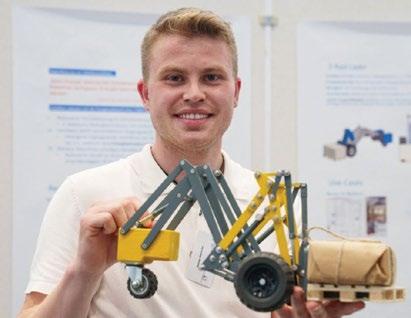
The Faresin/Zepplin deal covers both construction and agricultural machines with 10 models ranging from six metres/2,600kg to 17 metres/4,500kg. With both diesel and all electric power on some models. Zeppelin chairman Holger Schulz said: “Faresin Industries is responsible for the development of the machines, while we will handle sales and service in Germany and Austria.”
Sante Faresin added: “The German market represents a key opportunity with a potential of over 5,500 machines and we are sure that Zeppelin is the ideal partner to make the most of this opportunity in Germany and Austria.” ■
